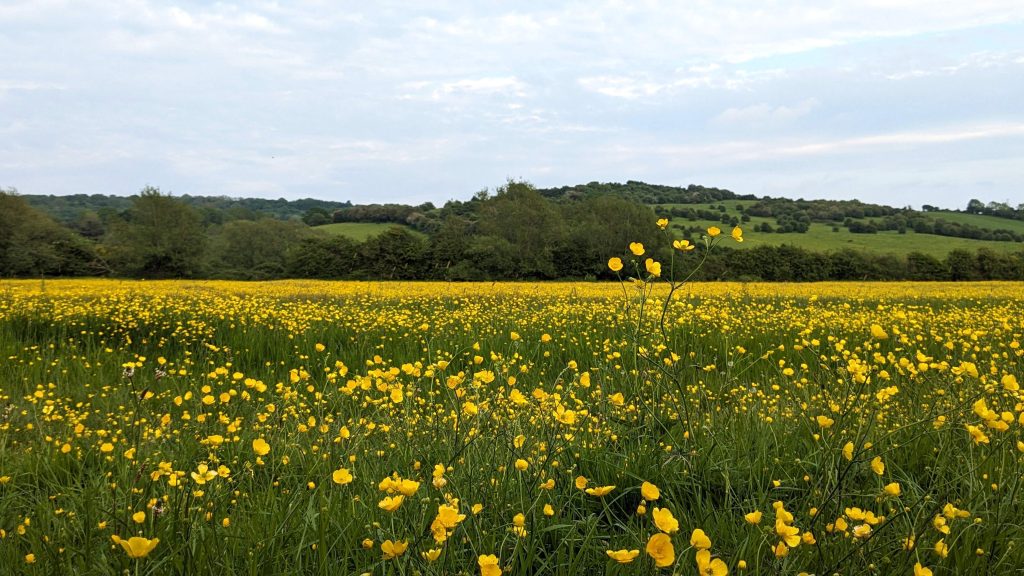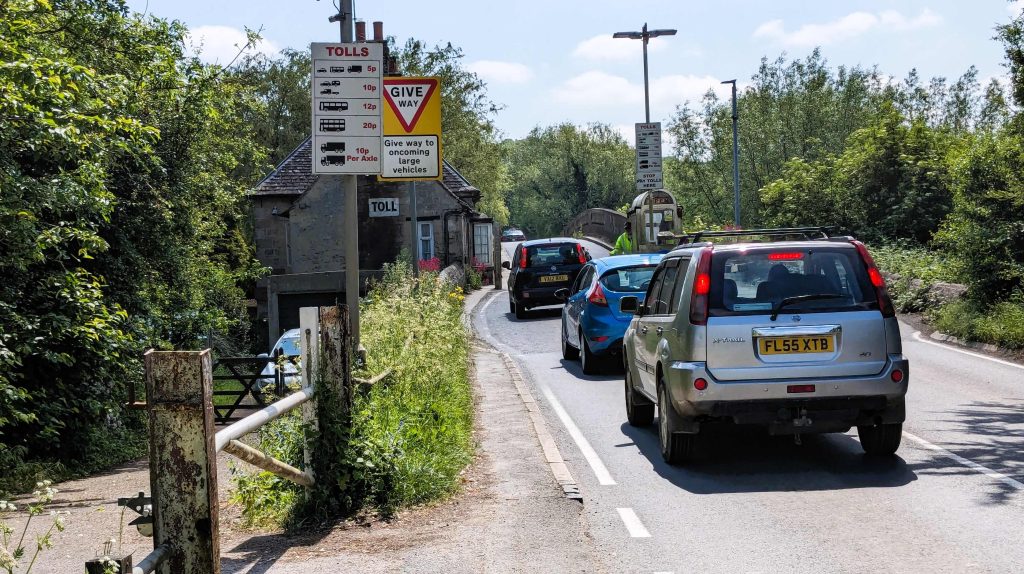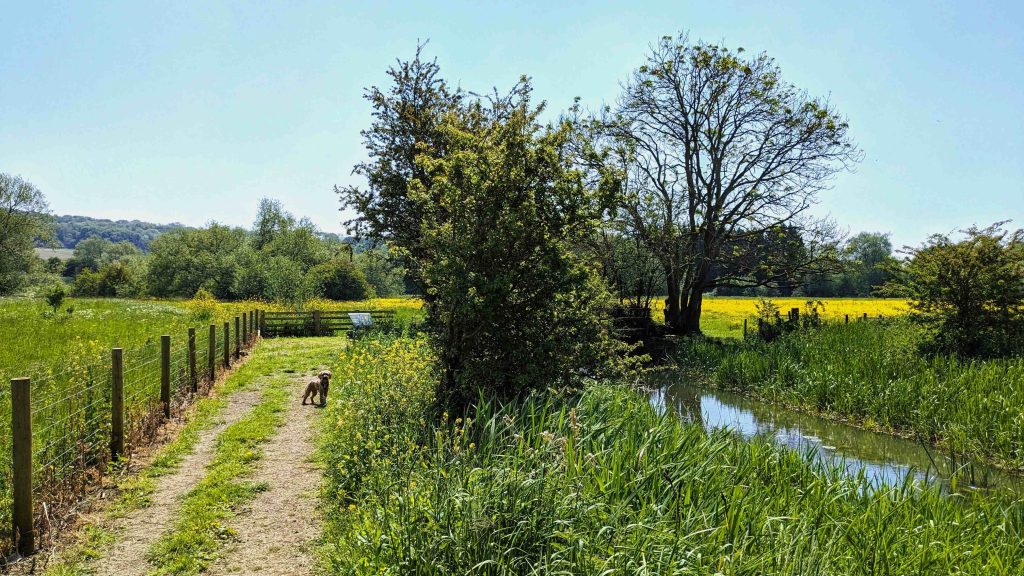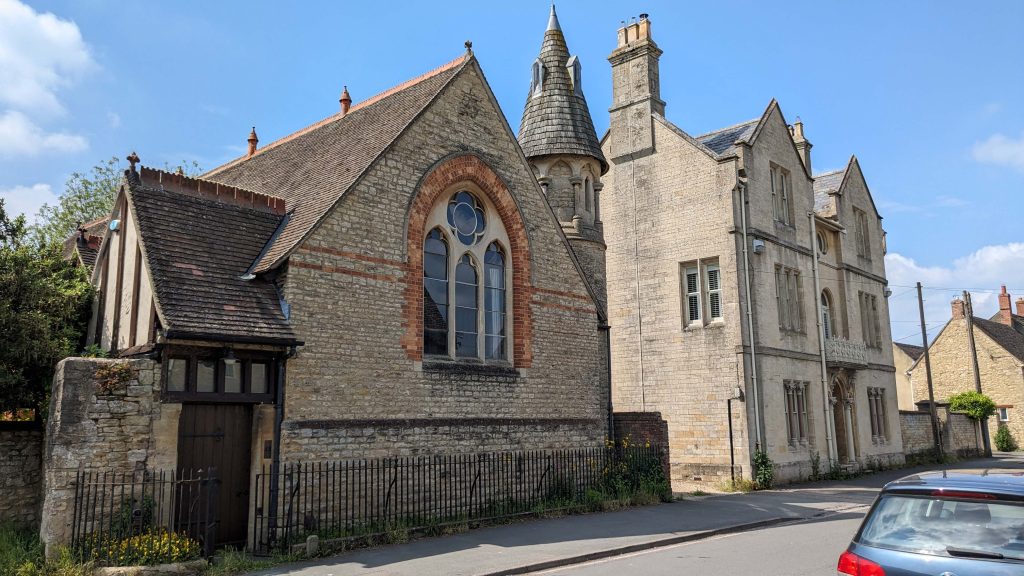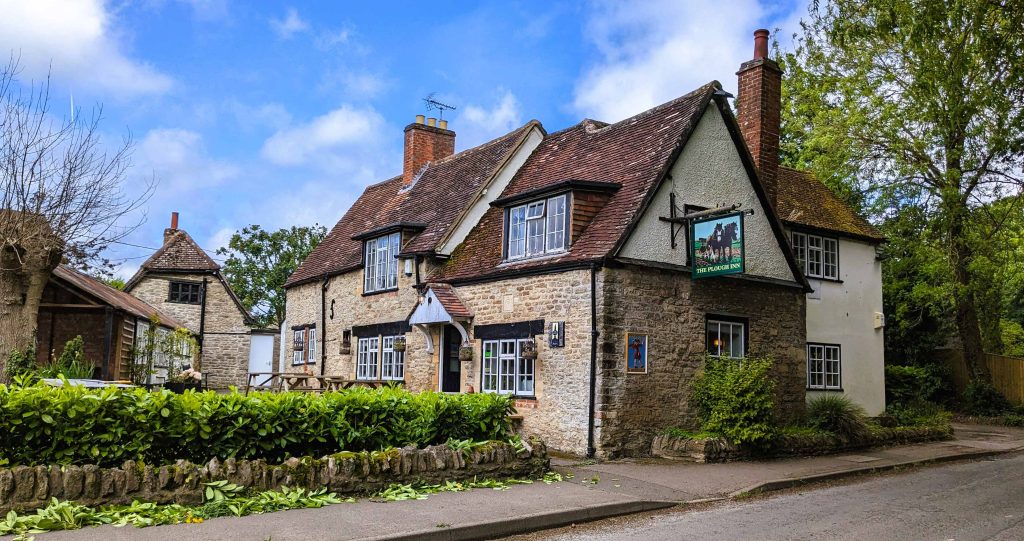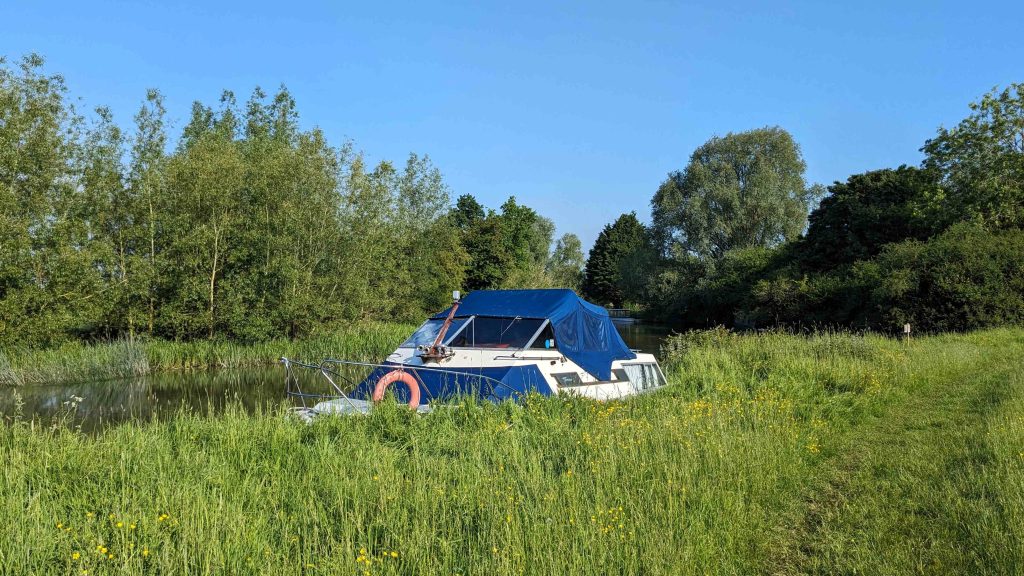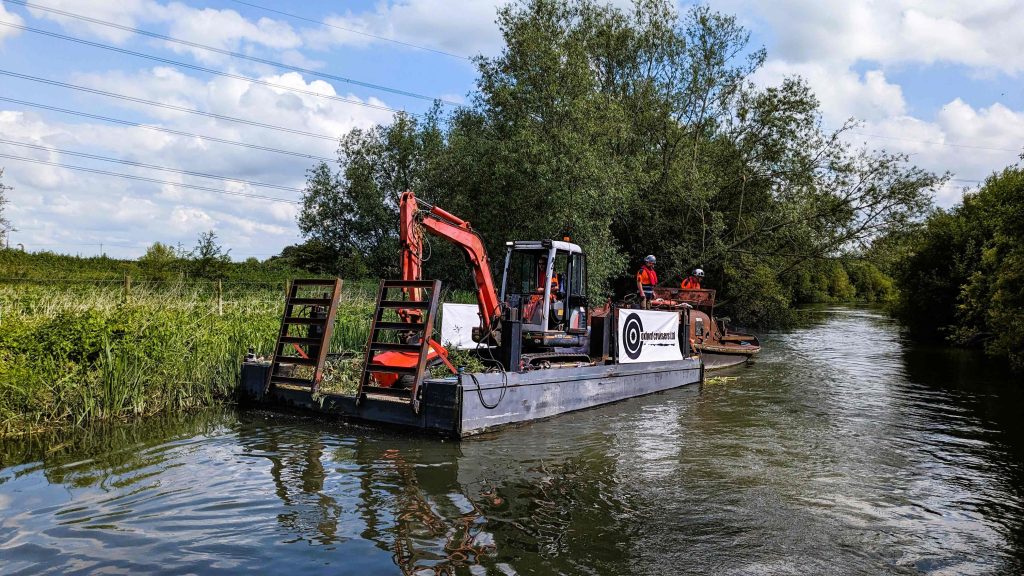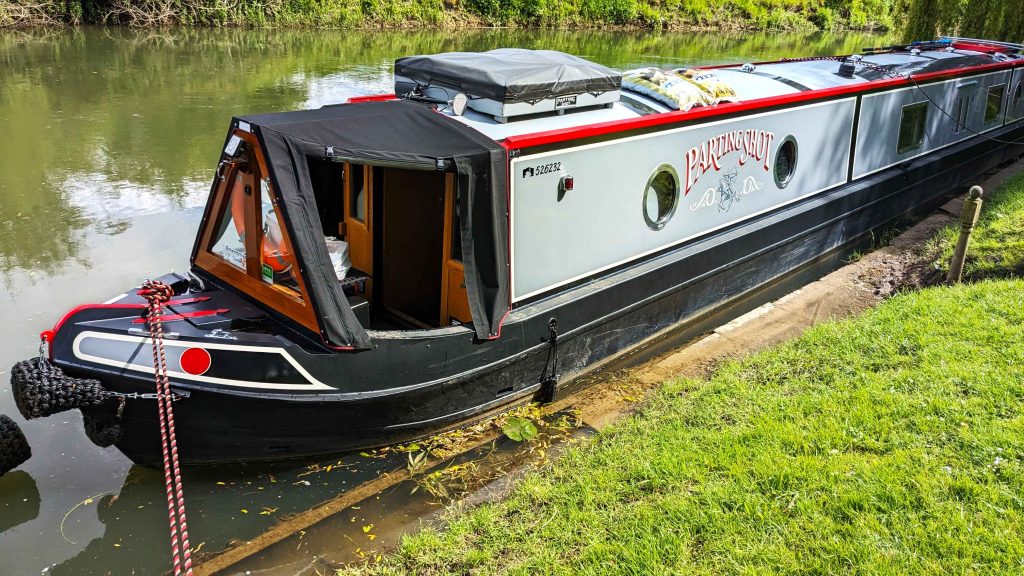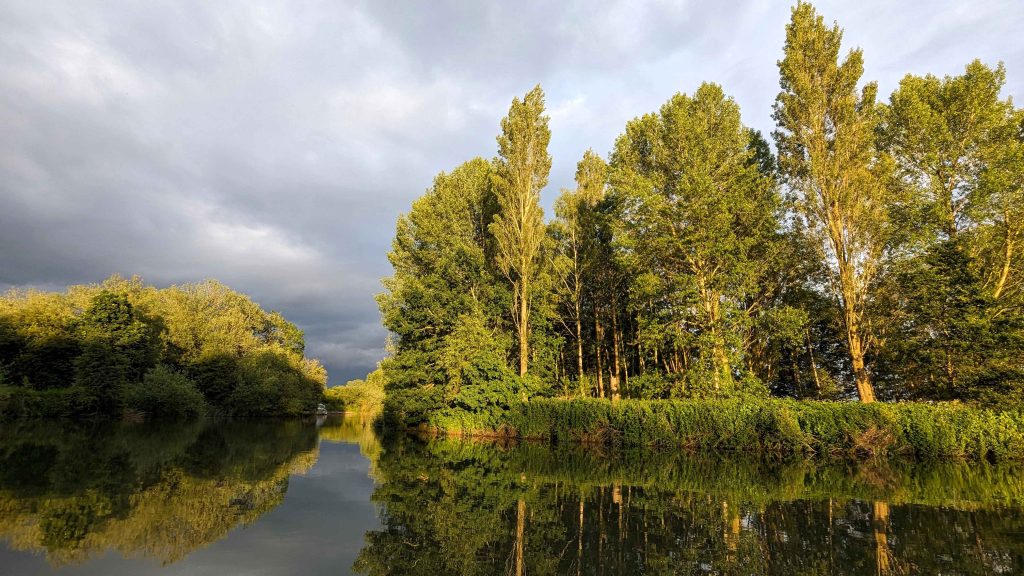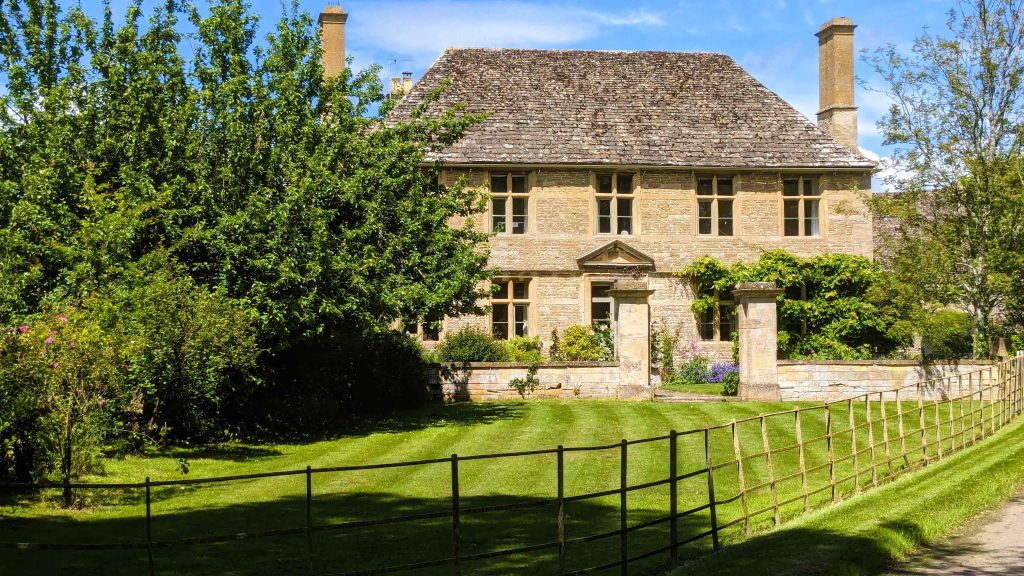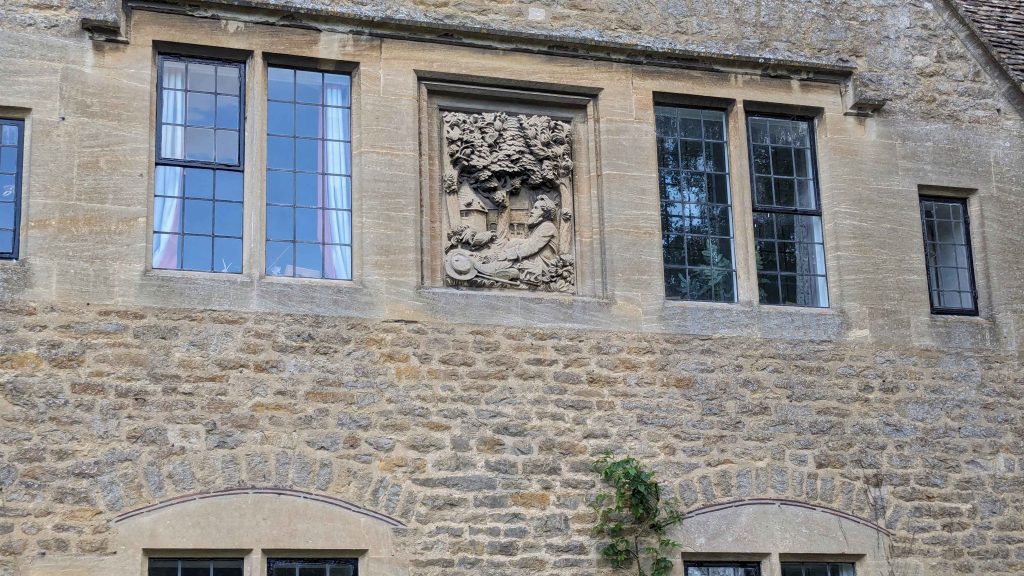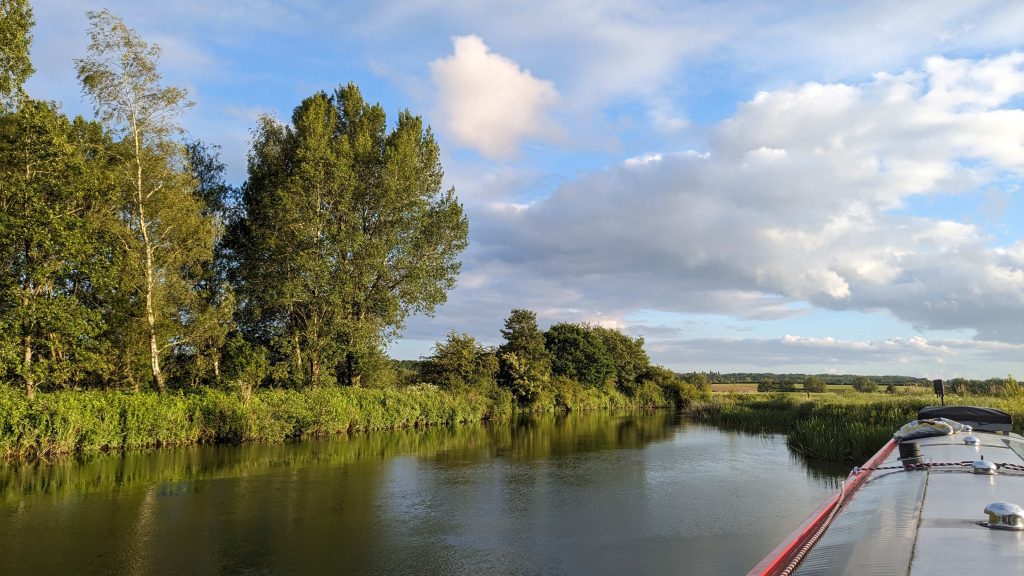Duke's Cut
With the gathering of the Alexander coven successfully concluded, we were ready to move on so, on Friday, seventeenth May, we headed down through Kidlington and on to Dukes Lock. It is a reasonable stretch of canal but a fair bit of the route is rather shallow and overgrown so dark and dingy at times.
Duke's lock drops down into a junction with Duke's Cut. Right takes you onto a short stretch to the Thames, while continuing straight on follows the Oxford Canal all the way down to the start at Isis Lock, which leads into the Sheepwash Channel to join the Thames further south. Arriving at the lock we caught up with "Argy Bargy", who had passed us as we were taking on water back at the Langford Lane Bridge the other side of Kidlington. He was single-handed so I went up to help with the lock and asked him which way he was going. Even as the lock emptied, he said he hadn't made up his mind, the Isis route being very slow, because of the number of boats moored along there, while Duke's Cut would be longer in distance and involve two Thames Locks. As we talked it became apparent that he was moving the boat for someone else and I realised that this was the guy we had followed from Braunston to Crick several years ago delivering a boat called "Moonlight" and also that I had met him when he had dropped off another boat at York while we were moored there two years ago - a small world!
I don't know quite when he made his decision but ultimately he headed off down the main canal when he left the lock, while we turned right into the cut and through Duke's Cut Lock on our way to explore the Upper Thames.
It is about a mile along the Duke's Cut and then the Wolvercote Mill Stream, a stretch crammed with liveaboard boats, some respectable, many decrepit and not a few simply underwater. The Mill Stream meets the Thames just above King's Lock, where we had an immediate reminder of the difference in navigating on rivers, as we foolishly attempted reversing back towards the lock where there is some overnight mooring. Wind and current made their effects felt at once and we began to move increasingly more sideways than in any intended direction. There is little steering control in reverse on a narrow boat and none at all when the flow is running faster than the boat. We abandoned that idea, which had really only been a last minute whim, and moved forward into the stream and on up to Eynsham Lock.
Here there was plenty of space to moor overnight, below the lock. We had the chance to pay the lockkeeper for our registration on the Thames, which is not covered by a standard CRT license. A one month permit has become a lot more expensive in the last five years and not just in line with everything else! At least the mooring was free and it was a nice setting with a view across the weir and access to all the services we need.
Enjoying Eynsham
We had already decided we would spend a bit more time moored at Eynsham and there were supposed to be good mooring sites available the other side of the bridge beyond the lock. We had a walk down on Friday evening to look at what was available and decided we would move down there the next day, Saturday, eighteenth May.
Coming through the bridge the river starts to meander. At first there are private moorings along either bank but just beyond a gate there is a wide meadow that has various places along its banks that are long, straight, vertical and deep enough to bring a narrowboat alongside. This was quite different from mooring on the towpath of a canal as the boat is up against a sheer mud bank, often taller than the roof. We were very lucky to find a nice clear spot, quite close to the gate and the route into town, where we could get our pins in and settle down with a view from the windows across a large expanse, full of buttercups, to the rising ground of Beacon Hill and Wytham Great Wood.
A couple of weeks ago we had begun to hear the call of the cuckoo and at about the same time, back at Aynho, Sue had heard the call of a bird she couldn't recognise. With the help of a clever app she was able to identify it as Cetti's Warbler, a relatively recent arrival in the United Kingdom and known for its skulking habits that make it very hard to spot. Having never heard of it or heard its call before, both the warblers and the cuckoos seemed to have pursued us from then on and here, once again, we could hear them all the time, to the point of their becoming quite irritating.
Over the next couple of days, as well as on a return visit on the way back, we came to know Eynsham and the area quite well. The meadow where we were moored was really in Swinford, across the river from Eynsham and reached, by road, across Swinford Bridge. Opened in seventeen sixty-nine to replace a ferry, the bridge is privately owned and remains a toll bridge, with a fee of five pence per car for each crossing. New owners, purchasing the bridge at auction in two thousand and nine, declined to remove the toll, to the frustration of some regular users who dislike the resultant traffic delays.
For the pedestrian, a short walk under the bridge and across the lock and weir, allows one to approach Eynsham via the Wharf Stream Way, which is a much more pleasant route.
The town is small and has many pretty and interesting buildings at its heart.
The abbey is no more and the site seems to be inaccessible to the public but the grounds around where it stood are well maintained recreation space. Arriving on a sunny Saturday afternoon, after a longer walk in the surrounding countryside we began looking for somewhere to have lunch. We located a sandwich bar called 'Snax' that had just closed at two o'clock. There were a couple of the staff sitting outside, smoking and we asked if there was anywhere else we could try. They directed us up the street to the Cherry Tree Café, which turned out to be delightful, dog-friendly and open until five o'clock.
We ended up having a number of visits to this establishment and its attached shop, full of fresh, local produce. We should be forever grateful to 'Snax' for their total lack of commercial nous and ambition. Had they had a bit more gumption, they could have sold us an inferior sandwich instead and we might never have found the Cherry Tree.
It was at least a twenty minute walk from the boat into the centre so we didn't visit the various pubs in the evenings. On Monday, twentieth May, it being Sue's birthday, however, we walked across the bridge to the Talbot Arms and had a good meal out there to celebrate.
There were plenty of nice walks around Eynsham, Swinford and the next lock down, Pinkhill Lock, during the day.
Pinkhill Lock was a particularly attractive setting but was, in many ways, typical of the Thames locks we encountered. The role of the Lockkeeper, in particular, was confusing. Mostly, we would arrive to be greeted by a blue sign saying "Self Service" and we would set about working the lock ourselves. Very often, however, the lockkeeper would be lurking in their cubicle and more than once, while we were moving at our own pace, they misinterpreted our actions and anticipated that we were about to do something they don't like and so would spring out and shout instructions we didn't need. It came to seem that the lockkeepers, in general, were far more interested in lawnmowing and gardening around the environs of the lock than in helping travellers through.
The New Bridge Misnomer
After three days at Eynsham, mostly in fine, sunny, summery weather, it was time to move on. Tuesday was greyer and cooler from the start and stayed dull all day. We set out for our first port of call, which was to fill up with diesel at Oxford Cruisers. They were ten minutes upstream, half way to Pinkhill Lock, providing boatyard services and running a large fleet of Anglo Welsh hire boats. Following the sign at the river entrance, which we had observed when walking down this way, we brought the boat through the awkward turn, under the footbridge and avoided hitting any moored boats while we then manoeuvred alongside the high dock, beside the diesel fuel pump. There was no-one there so I walked round to the offices and workshop to get some assistance. Finally, I did find someone working on an engine and he told me they no longer sell diesel, they just find it unprofitable now.
This was a blow. We weren't that low but it had been a while and there didn't seem to be anywhere else to fill up between Lechlade and Oxford. I did manage to persuade them to let us fill up with drinking water before we reversed carefully out into the current and carried on up to Pinkhill Lock, where we encountered "Ubique" and yet again, "Runaway Parents" coming down. We picked up some useful tips from them and moved on through Northmoor Lock. The river was starting to wind now with a few tight corners and tricky bends. We found a mooring spot on an old wharf before we reached New Bridge. Again we had to learn a bit about the effects of river currents as we tried to get onto it but got pinned in quite securely in time for lunch.
We were about ten minutes walk, along the river bank, from the New Bridge. The care needed when choosing what to call things is well illustrated by the fact that "New" Bridge was built in the thirteenth century and is the second oldest bridge over the Thames, next to Radcot Bridge. Even Radcot's claim is disputed since it had to be extensively rebuilt, following heavy damage incurred in the Wars of the Roses. Archie and I took a walk down to the bridge, with the Rose Revived pub on one side and the Maybush Inn on the other. Oxford County Council seems to have a policy of letting footbridges on its public footpaths rot away and then closing the right of way for "reasons of public safety". As a result, we had a slightly difficult circular walk through the fields before we could cross back to the boat via Hart's Footbridge but we made it back in the dry.
At four o'clock it started to rain, getting progressively heavier through the rest of the afternoon and evening. As far as we know it didn't stop all night and it continued throughout Wednesday. During the day, as the river went on to 'Yellow, Stream Increasing' status we made sure the bowline was around a securely rooted tree and we put in additional pins to support the original ones. At about six o'clock in the evening it finally stopped. At that point we put on our galoshes and splashed down to the 'Rose Revived', if only to assuage the cabin fever from being trapped inside all day. In all, we gather, a hundred millilitres of rain fell in just those twenty-four hours, against a norm, in Oxfordshire, of around sixty millilitres for the whole month of June. All the upper reaches stayed on 'Yellow - Increasing' the next day, with some 'Red' near Oxford. Finally, some went to 'Yellow - Decreasing' during Friday. We aren't intrepid, white-water, river cruisers so we chose to wait it out until Saturday.
Despite the issues with the depth and flow. the weather, itself, was not too bad, so we were able to get out during the daytime. On Wednesday we walked back to Northmoor Lock and crossed the lock to the road up to Appleton. Apparently, this is not a public right of way and the EA have to pay a couple of thousand pounds a year to the landowners to allow their lockkeeper to use the road. We took our chances and didn't see anyone to challenge us as we climbed up to the village, where we found an excellent shop and café. It has been running as a Community Shop, staffed entirely by volunteers, since the year two thousand, when the original owners were unable to find a buyer for the business. It is encouraging that this model can be so successful for so long. It is quite a pretty village, generally and even has a village pub.
Around five o'clock on Friday afternoon a large cruiser, "Lady Jaz II", came sweeping round the bend and along our port side with one of the crew frantically fending off. Our original assumption was that they had just lost control on the bend but then it seemed they had been aiming to get in to moor. With a good deal of shouting and waving they got someone on shore with a line, a hundred yards or so downstream and having gone through a three hundred and sixty degree pirouette, finally had her pinned on to the bank. We heard later that there had been a request for help on Facebook and then the crew had been seen walking down towards the bridge with all their luggage. Apparently, they had caught a lot of rope around their propeller and were stranded. We had never considered this issue before, in relation to big cruisers with inboard engines. Where we would just open the weed hatch and apply hours of brute force and colourful cursing to free the obstruction, it seems these kind of boats are not able to deal with the problem without being taken out of the water or at least, someone getting right in and under the surface.
On Saturday, twenty-fifth May, we felt comfortable to move on. The only area locally still looking very 'fresh' was the Windrush River, which flows into the Thames right at a point upstream from where you emerge through the bridge. We negotiated that with relative ease, although the incoming stream certainly made its presence felt.
As we rounded a bend on the way to Shifford Lock, however, we encountered, without warning, a couple of large workboats with a huge digger on one, working on the vegetation but completely blocking the channel. Once they saw us, they moved back, decoupled and let us through but it took a while with us just trying to hover in midstream.
We stopped at Shifford Lock to take on water, which proved to be another very slow tap, with a lot of leakage, so it took nearly an hour to fill up. We were going against the current and we encountered increasingly tortuous bends, almost coming a cropper on one of these under Tenfoot Bridge. It was about five miles and took nearly four hours altogether but we were amazed to find, on a very pleasant, sunny Saturday lunchtime, that the mooring available to patrons at the Trout Inn was completely empty. It was only a couple of boats long, very muddy, virtually underwater and up against a very steep grass bank, with no rings or bollards but we were able to get pinned in and delighted to find it. Later in the evening we were joined by "Knot On Call" whose position on the upstream end of the mooring was even more precarious.
Archie and I went for a walk in the afternoon and checked out the next lock and its facilities. Then we fulfilled our obligation as patrons by enjoying an excellent dinner in The Trout Inn. The garden and interior were really well refurbished and maintained so it seemed a pity that the pontoon was so neglected. We couldn't help being seduced by the offer of their excellent breakfasts on a Sunday morning so you could argue that we paid quite dearly for a rather sketchy mooring.
To The Manor Moored
Several hours of heavy rain overnight, followed by showers in the morning, got me to thinking that, if the river levels did rise again, we were probably in a very vulnerable position, with the solid mooring just about on the waterline. It was an incentive to move on quickly and we got going soon after breakfast. The weather had turned rather kinder, in the meantime, although somewhat windy and we made the trip in dry, sunny conditions. On the way we came through Radcot Bridge, highlighted on the map as having a particularly small arch. We didn't have too much difficulty with the arch but it leads straight into a very sharp, blind bend and we did wonder how it would be when approaching it going downstream.
Our aim for Sunday night was an area of forty-eight hour mooring shown at Kelmscott Manor, which proved to be a stretch of uneven, high river bank that was very badly overgrown both in the water and on the land. Within it we could identify one or two bays that we thought a narrowboat could get into and managed to scramble ashore and bang in the pins again to secure us. We moored under an ominous grey sky, with a rumble of thunder in the background and we did have a couple of brief, heavy downpours during the afternoon but it all cleared away for a lovely, sunny evening
Kelmscott Manor, taken as a retreat by William Morris and providing him with much inspiration is now owned by the Society Of Antiquarians Of London, who also claim to maintain the moorings. It is open to the public, with all the usual exploitation of a tearoom, gift shop etc. Weirdly, however, it only opens from Thursday to Saturday and definitely not on Bank Holidays, so we weren't able to visit it on the way up. As we came back down we stopped here again. As it was then Thursday, the house was open. The village is quite extensive with some very fine and expensive looking properties, despite some of them being labelled as 'cottages'. They don't allow dogs so I took Archie for a walk while Sue visited the house, which she found very interesting.
We had a surprise message from Sharron and George, Jen's in-laws, on the Sunday night. They live in Oxfordshire and we arranged to meet them the next day. A couple of miles away, on the opposite bank, is the pretty Thameside village of Buscot, with associated weir and lock. It was part of Buscot Park but is now largely owned by the National Trust with many of the houses rented out to long term residents. I could not find any information on how or when this came about or to what purpose, which makes it all the more intriguing. However, it has a lot of car parking, a lot of visitors and a lovely little independent tea room with a large garden. Sue and I walked over there to meet the Jenkinsons and had a pleasant catch-up, including with Tilly, their latest apprentice hearing dog puppy.
Afterward, we walked back to the boat across the lock and along the Thames Path to spend the afternoon relaxing in unusually pleasant sunshine for a Bank Holiday Monday.


